Raquel Vasquez, just hours after killing Madeline Feliciano and critically injuring Oscar Ramos-Garcia at the intersection of Park and Washington in Hartford, was arrested and charged with operating under the influence, evading responsibility resulting in injury, evading responsibility resulting in death, manslaughter in the second degree with a motor vehicle, assault in the second degree, reckless endangerment, reckless driving and operating an unregistered motor vehicle. They could have applied the Vulnerable User Law, but didn’t, and we’re unlikely to see that put to use until bicycle and pedestrian advocate organizations get loud about it.
The quick arrest following the fatal hit-and-run is unusual, though, and a welcome change. If any arrest has been made in the killing-by-car of Luis Daniel Rodriguez — struck down while riding in one of Hartford’s bicycle lanes — that has not been publicized. Many of those who killed pedestrians and cyclists in Connecticut this year have gotten away with it, either because they have not gotten caught or because the system doesn’t think our lives are worth more than a slap on the wrist.
I wish I could say more about Feliciano. She lived in the neighborhood, just blocks from where she was hit, and was using a wheelchair to get wherever she had been going. There is no obituary that I can find.
Less than one week after Vasquez hit two people in Hartford, a 25-year old Yale law student was killed in New Haven. Keon Ho “Chris” Lim was cycling through the poorly designed intersection of York and South Frontage, and following the advice that cyclists are repeatedly given — stay as far to the right on the roadway as possible, so as not to be an inconvenience to cars. New Haven’s mayor, in comments to the media, implied that Lim had attempted to merge into the center lane but due to heavy traffic was unable to make that move.
Put in a damned if you do, damned if you don’t situation, Lim was fatally injured when the driver of a box truck turned right from a center lane (where that turn was permitted). into the victim, who had been continuing straight despite being in the right turn lane. The news reports and crash diagram contradict one another when it comes to whether the truck hit Lim or if the cyclist rode into the side of the truck, and if so, which part of the truck.
This intersection is a known problem for vulnerable road users. Two pedestrians were killed here in 2008 and 2017. This year-to-date, there have been twelve preventable deaths of pedestrians and cyclists in New Haven alone.
Also in October, a 67-year old male — whose identity has not been made public, if it is known at all — was killed in Waterbury. This was another case of a driver refusing to take responsibility for his or her actions. The man was pushing a shopping cart when hit around 8:15 PM near 760 Wolcott Street. NBC30 stated that the assailant “kept driving with the pedestrian still on the hood of the car, according to police. Police said that when the car took a right turn, the pedestrian rolled off the hood of the car and fell onto the street.”
To put it another way, there is no possibility that the driver was unaware that he or she collided with a person.
The victim suffered leg and head injuries, and died 48 hours later in the hospital.
The driver drove away.
Since January 1, 2020, at least 50 pedestrians and cyclists have been killed in Connecticut following strikes by or collisions with motor vehicles.
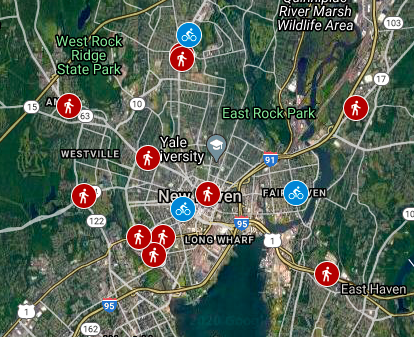
Since February I have shared with you statistics, obituaries, laws, history, current trends, explanation of Complete Street infrastructure, maps, and photos. What I have not shared is my daily experience as a person who walks to work — and for the last few months and foreseeable future — and to anywhere else I want or need to go. Throughout October, I kept notes. Here is what I experienced on thirteen days.
Day One:
I get off at the wrong bus stop in West Hartford because I am on a route I’ve never used before. This means a 1.5 mile walk when I expected to go about .25. Fine. Except that in this distance, there is only one painted crosswalk. Most of this walk is along a high-speed stroad. Laughably, they painted sharrows on it. I see many cyclists, but they are all on the sidewalk, not on the street — because those teens are not idiots! Well, all teens except for one adult who probably just got off his shift in a retail area where buses show up every half hour or hour, not every ten minutes. He is also on the sidewalk. Every intersection I cross — only one of which has a pedestrian signal — I hold my breath and pray while walking. Again, only one of these eleven intersections has a painted crosswalk, which means that if I get hit by one of the bloated vanity trucks that dominates the roadways, the news will report that I was not in a crosswalk because most journalists do not understand that unmarked crosswalks remain legal crosswalks. Hell, most cops don’t get that either.
Why didn’t I just take the more convenient bus that I had ridden before? Coronavirus. This was my first time on a bus since March, and I knew one route had fewer riders in general, which would seem like a safer bet for my health. These are the decisions you get to make when you are car-free: do I put myself on a bus where I may not have ability to be more than six feet away from another person but am dropped off at my destination, do I take a less convenient (i.e. more distant) bus reducing my exposure to COVID but still exposing myself to many opportunities to get run over by careless drivers, or do I walk three miles and stay off public transportation feeling confident about the air I’m breathing but having many, many conflicts with drivers while exhausted after working all day and those three miles only account for getting to the store; getting home means asking all these questions again, but with an extra two miles of walking potentially tacked on.
My return trip meant taking another less popular bus route, but this was a route I had taken before and I knew where all the stops were. The inconvenience cost me only seven more minutes instead of 25, and in this case, far fewer street crossings, all of which had painted crosswalks. Paint does not protect me physically, but perhaps when I am splattered across the pavement, the painted crosswalk will protect my reputation as a rule follower who could not be protected by the rules.
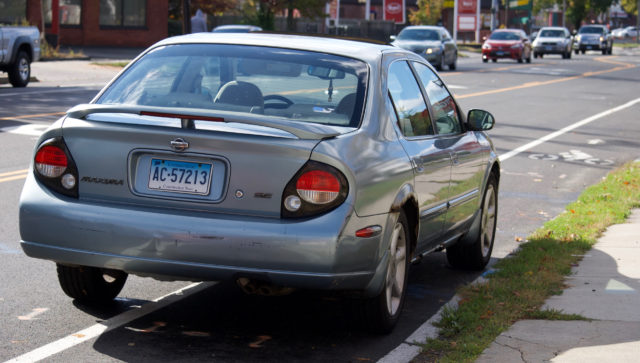
Day Two: The morning begins with entering another 311 complaint for an issue that had not been dealt with: cars being parked in a crosswalk by an elementary school. There are ample security guards around the school (including two who chat every morning by the corner where the cars are parked, one of whom does not wear a mask) and a crossing guard at this intersection. While they may not have the legal authority to enforce anything, it is beyond me why people — whose entire job involves safety — would not ask someone to move their vehicle to a place conducive to maintaining the safety of children. Listen, I get that drivers do not always listen. I’ve volunteered at a farmers’ market where part of my role involved telling people they could not park in the bike lane or in a travel driveway, and that they should move to the spacious parking lot that had about twenty signs pointing to it. People can be rude and act entitled, use coarse language, and simply ignore the instruction, but, many will move their vehicles along. Why wouldn’t they just try?
It’s an irritating way to begin the day, with this reminder that people believe cars are allowed everywhere, including spaces that are designated for people. We are battling another plague in America, and it’s called the absence of empathy.
By the time I am nearly to work I am in a mood. Walking should be relaxing. But all around, I see a world that has been reconfigured to meet trashy ideals and utter laziness.
And then I see the thing that makes me want a cocktail before 9 AM: landscapers using leafblowers to move pine needles off a driveway and into the roadway, right where cyclists are most likely to be riding. Nevermind that I do not understand how leaf blowers have replaced rakes, nevermind that their use is almost always to make something look neater than to actually address an issue, and nevermind that was I observed is super common and not necessary: there is a large green space that those needles could have been moved to; the street was not the only option. Nevermind the ridiculousness of moving leaves and other vegetation off private property and into public space. What I witnessed here and many other times is an absence of caring about how one person’s actions impact others.
Let’s think about those needles. Pine needles, in case you’ve never experienced them yourself, are slippery. What does it mean when one person takes a slipping hazard and moves it to a public space? Think about what it means to pile leaves into the bike lane or across a sidewalk. The message is that how the property owner looks (by way of how his/her lawn looks) is far more important than the safety of someone walking or cycling to work. I could explain it step-by-step what it means to constantly swerve around leaf piles, becoming that “unpredictable” cyclist that we are told not to be, or what it means to have to step out into the roadway because a sidewalk is blocked, and if that pedestrian gets hit by a car, you can guess what the news will report: it won’t be the obstacle that person was avoiding; only that the person was walking in the roadway, as if people do this without reason.
You might think of these things as small matters, but they aren’t. These obstacles can force someone into a split second decision that results in death. All because someone couldn’t be bothered to bag leaves or just leave them on the lawn where they fall.
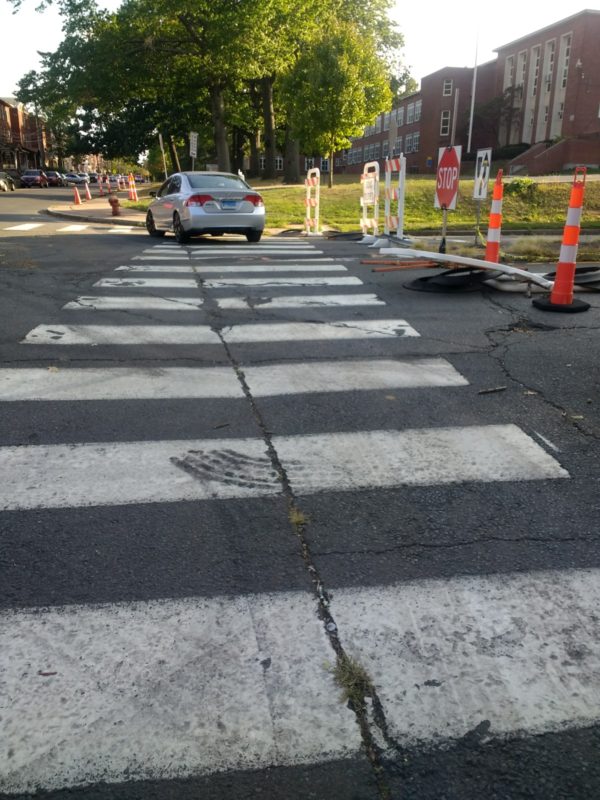
Day Three: To vote by absentee ballot, I take a detour on my way to work, swinging through Parkville so that I can place my envelope into the drop box. This is in front of a school and senior center. It takes all of three seconds, plus the time to douse my hands with sanitizer. Then, I wait for the pedestrian cycle. The intersection of Park Street, New Park Avenue, and Sisson Avenue is a cross-stroad. It’s bloated and teeming with entitlement. Nobody uses the stop lines. Those are the solid white lines by the intersection that the vehicle is supposed to stay behind when unable to clear it.
Here, the crossing guard has the guts. She blows her whistle at the driver who decided to block the crosswalk with his pickup truck after all lights turn red and people on foot finally have the right-of-way.
In the West End, the crossing guard pops out into the street with his sign. This is notable because there are no kids in the intersection, and over the years, he has consistently made the kind gesture of serving as reinforcement when adults are crossing. Here, everybody gets an extra layer of protection, regardless of age.
This morning I find myself missing the crossing guard who used to patrol Russ Street at Putnam Street until she retired a year or so ago. She was the right kind of terrifying and would absolutely stop traffic. By the way she greeted the students, you could tell that she felt her job on a personal level, that she was there to actually protect and serve.
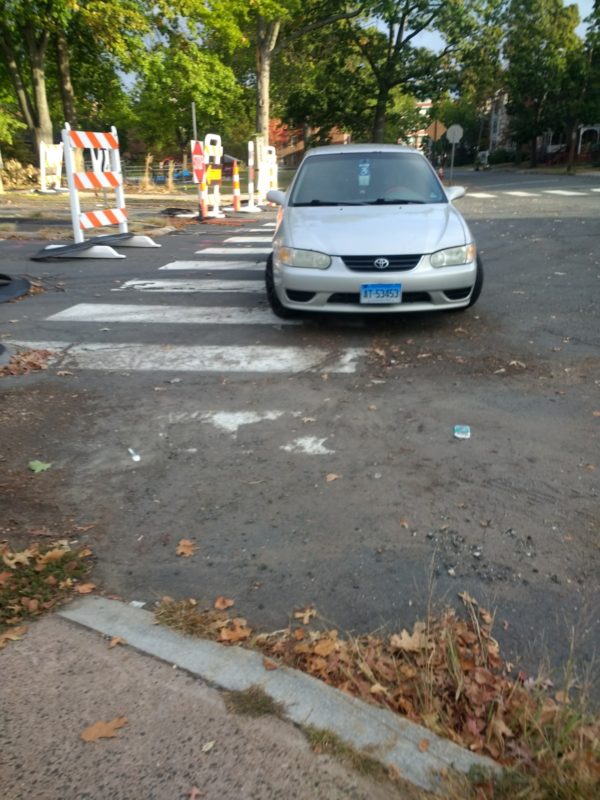
Day Four: I am pleasantly surprised to see that someone figured out a simple way to solve the problem of selfish drivers parking in the crosswalk by an elementary school: cones. That’s all I ever wanted. Not cops to come by and potentially exacerbate a situation. Just physical barriers (well, obstacles, really) set down where they should have been in the first place. It’s not perfect, but I did not have to be the person to relocate traffic cones from where they are serving no function to where they can give pedestrians a little more of a fighting chance.
But before I see this, I pass a loud altercation. Another entitled driver up the road is yelling at a bus driver. He parked his car several feet away from the curb, making it so that the school bus had to be overly maneuvered to get through the space remaining. Who yells at school bus drivers?! The same people who think that they are allowed to park any which way because they did not leave the house early enough to get their kid to school on time.
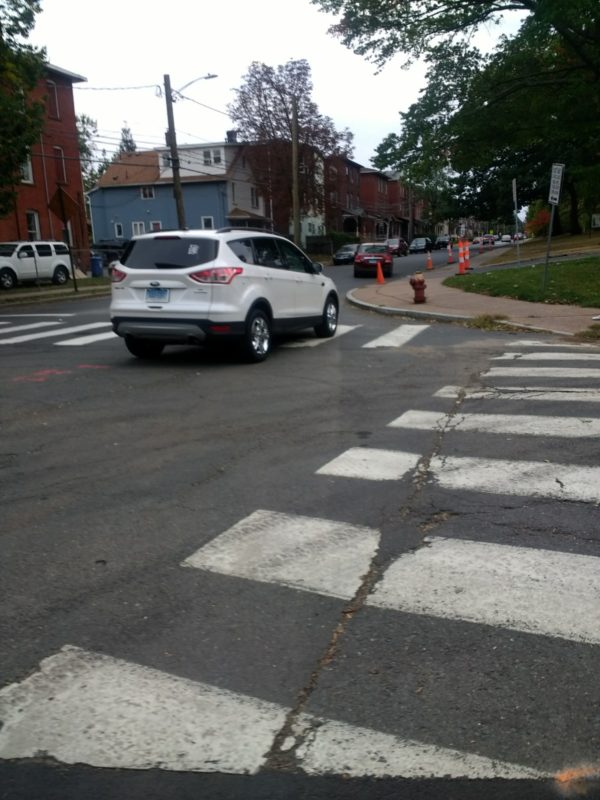
Day Five: There are fire trucks parked all over Park Street near Orange Street. Common sense says people should slow down and use extra caution. Instead, cars are still zooming on this stretch of road, and I nervously watch as a pedestrian uses an unmarked crosswalk, knowing that if she gets hit, the news crew will describe her as jaywalking.
This is on the section of Park Street that I and others have reported to 311 as needing traffic calming. There are no significant bumpouts or anything at all that slows traffic. I continue to implore the business and property owners in this area to step up to do something, but it’s spitting into the wind. A shiny new development has no front door access. Color me shocked that the centerline yield signs are never where they should be. If you think I’m grumpy, wait til one of the hipsters gets hit by a car. Just wait. It’s when, not if.
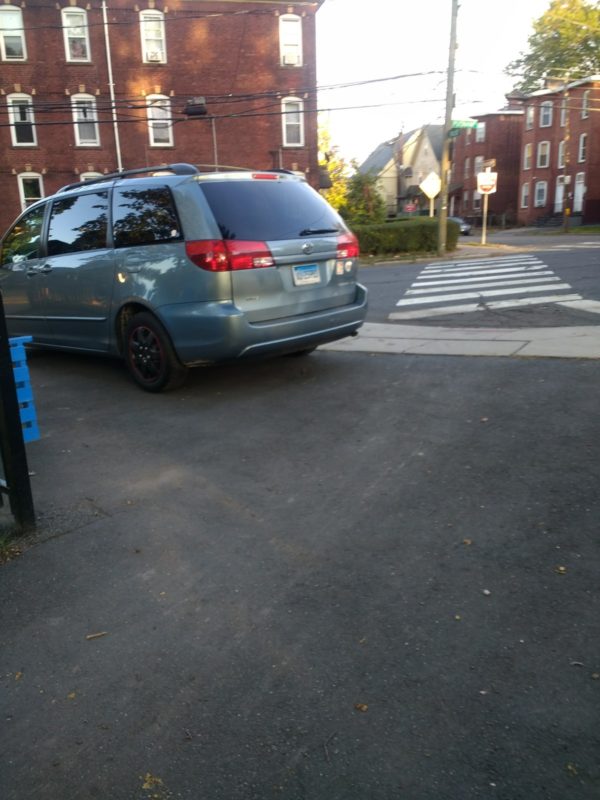
Day Six: We have been in a drought, but today is pouring rain. I have a change of clothes in my bag so that I don’t need to shiver all day at work. That’s experience talking. Every time it rains, there are three ways for me to get soaked: (1) If the rain is coming at an angle, making my umbrella less protective, (2) getting splashed by the morons who are driving too fast for conditions, and (3) while crossing roads where nobody has bothered to clean the storm drains.
Today, I manage to be spared by drivers, and do not have to wash disgusting puddle water off my face. My feet, however, are drenched. The storm drain at Putnam and Russ has been clogged for months. When the construction crew set out barrels, one was placed blocking a curb cut ramp. Besides impeding wheelchair access, it has become a thing for leaves and litter to congregate against. In the suburbs, you would see maintenance right next to a school. In one of the poorest neighborhoods in Connecticut, there is no such luxury. I mean, a squirrel has been rotting away in the school drop-off zone for weeks. Sure, some crew played with their leaf blowers on the lawn one day when it was there, but you can’t expect someone to stop playing with their loud toys and actually remove a hazard. It’s frustrating to have to constantly report such things to 311 for there to be any hope of getting things done.
The storm drain was completely blocked. Dirt from the construction project washed down, gathering over all the garbage and leaves. There was no way to get around the puddle without going in a different direction. So, my feet were soaked in less than five minutes outside, and there would still be other intersections with puddles. It does not help matters that the storm drains and curb ramps often overlap or are too close to each other to be of benefit to the pedestrian. Even if the one by the Burns School had the cone removed so you could walk off that instead of having to step off a curb, the drain remains an issue. Maybe I see it this way because there is no maintenance of it here, and that is typically the case elsewhere.
I get to work. Head straight to the bathroom, after remembering that I had more spare clothes in my locker. I opt for wool socks from there. I shove paper towels inside my boots to soak up water while I’m changing my socks and pants. Everything is great until slowly, my socks begin to get saturated with water remaining in the boots. I spend the day with damp feet. You can imagine what that does to a mood, but at what point do you say enough? How many pairs of spare socks should I keep at work because the City of Hartford will not maintain its property? How many spare pants should I keep there because drivers will, rather than pause while the car in front of them makes a left turn, weave to pass on the right, dislodging a puddle with their impatience and selfishness?
I’m asked why I don’t take the bus when it rains. Simple. The bus makes no difference. I still have to walk .4 mile to get to the bus stop — and that means going through the same intersection. With the major construction project on Park Terrace, there is no shorter alternate route. Then, on the other end, I still have another .4 mile walk from the closest bus stop on that route. I pay money to stand around and wait for a bus that only shaves about .7 mile of walking, most of which is not the part with massive puddles? No. Why don’t I take Uber or Lyft? COVID-19 concerns aside, it feels like a waste of money and like taking an unnecessary risk to get in a car with what is almost always someone who drives too fast for conditions.
You know what is inevitable though, when you have walked about two miles in the pouring rain? Hearing someone talk about where they parked so they could avoid getting wet for thirty seconds.
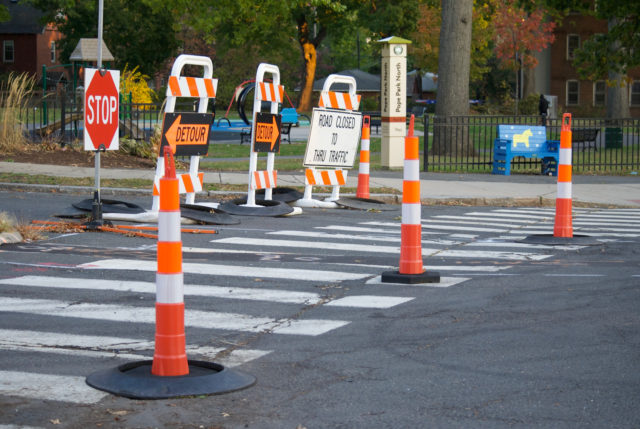
Day Seven: One step forward, two steps back. A car was parked again in the crosswalk. How many cones are needed to tell someone that this space is not for them? How much pavement do drivers feel entitled to? Why is there so much entitlement? There is no shortage of parking in the neighborhood. There is no reason for someone to park in a crosswalk. To get anything done, I would have to contact the police because no other department seems to think it’s their responsibility to follow up with the construction crew and ask that signs and cones be moved to be sensible and functional. You would think that a clear ADA violation would have done it, but no.
Besides not wanting to call the police because this should not be a police matter, there’s another thing: it’s not like I’m taking walks for funsies when I observe this garbage. I’m usually walking with purpose — going to or from work. While I think I am responsible by leaving early so that there is some flexibility and I’m not late, I definitely bite into that time whenever I stop to record something with 311. In this case, there’s nothing for me to be late to except starting dinner, but I’m tired and a phone call with a dispatcher will be unpleasant because I do not like repeating myself three times. Again, I fantasize about moving the cones to where everything should have been placed the first time. I fantasize about smashing the windshields of being too dumb to operate a potentially lethal piece of machinery. But I don’t do those things. Instead, I go home, make dinner, and try to tell myself it’s okay that I not attempt to make shitty things better, even if it seems like few others care to do their share of heavy lifting. I let myself do what I never do: nothing.
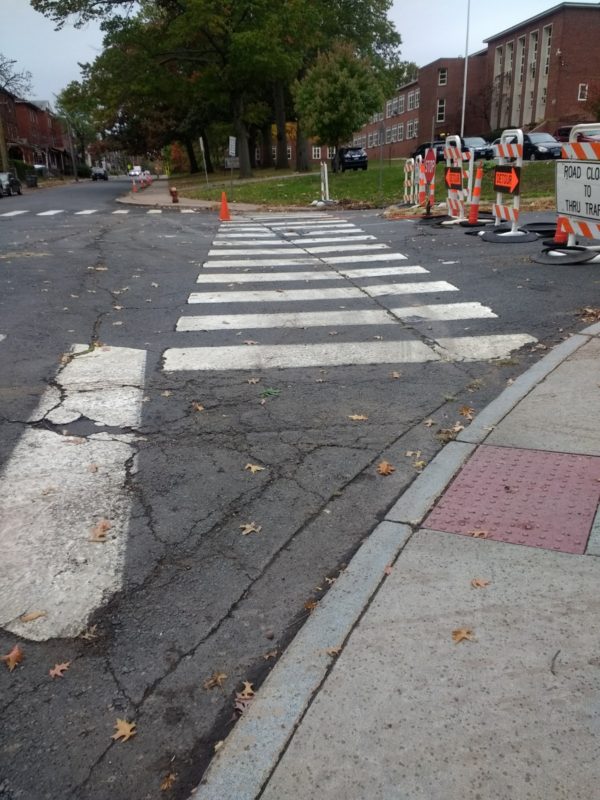
Day Eight: Before I leave the house I am sending an email to Complete Streets asking if they can get a more appropriate department to address the pedestrian accessibility issues at Putnam and Russ — from the cars in the crosswalk to the blocked curb cut ramp.
For the first time I’m regretting not spending my adult life working out; if I had the physical strength, I would just move things myself. It would be weeks before the City of Hartford noticed something changed.
How do I know?
The photos in this post of the Capitol Avenue sidewalks partially and completely obstructed by vegetation — I reported those issues using Hartford’s 311 app. I first reported it back in July. And again in August. Then, later in August. And in September before school began. And once more at the beginning of October. These photos were taken October 31, 2020.
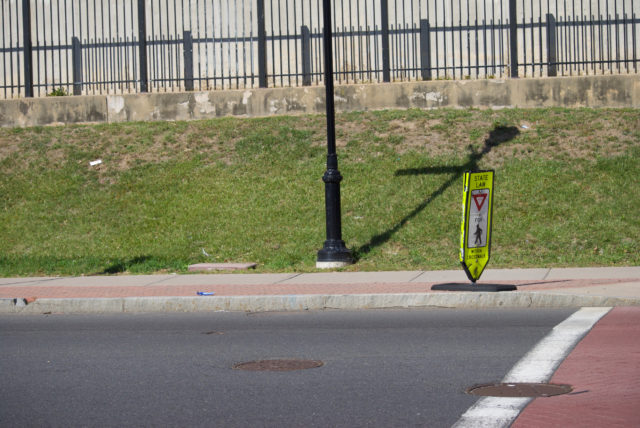
Day Nine: I am told to go check out the intersection of Russ and Putnam to see if the construction crew fixed the situation. The sign blocking the curb ramp has finally been moved, restoring access for those using wheelchairs and strollers. . . after months.
I should be grateful, but I have to ask why it was not done mindfully the first time. Because the sign is moved, it seems the storm sewer won’t get backed up as easily either. But, I notice that all but one cone has been moved away from the crosswalk, making it more possible for people to continue driving into it.
This is frustrating.
We don’t need cops. We need physical barriers.
Physical barriers are what keep almost all motor vehicles out of bike lanes and walking paths. They are what prevent people putting their cars into places they should not.
We also need people to raise their children up right, to be less self-centered. People who commute by foot or wheelchair or bicycle should not have to beg to be safe.
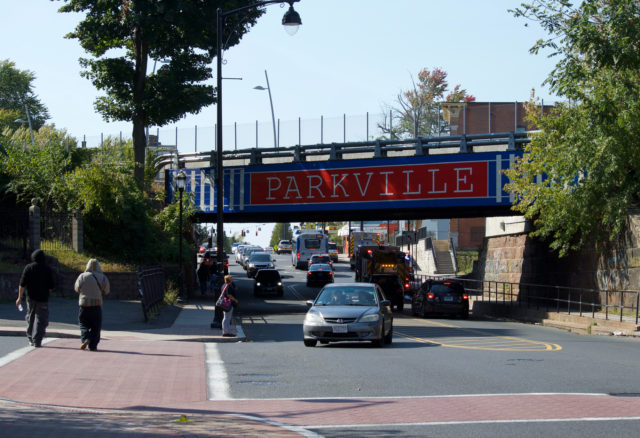
Day Ten: It’s the weekend, so I have time to visit Goodwin Park. I decide to stop by the post office on the way, which means walking through the intersection of Park and Washington Street in Hartford. That’s where Madeline Feliciano was killed about two weeks prior. While waiting my turn to cross, I glance at the people waiting at other corners. Are they feeling a little nervous too, knowing what happened here? Do they wonder if drivers will stop when the light tells them to?
On the way to the city’s South End I notice cars parked in the relatively new bike lane on Maple Avenue. People park cars in bike lanes when there is (1) no physical barrier keeping them out, or (2) no consistent ticketing and towing of vehicles parked in bike lanes. I abhor sharrows, but in a way, they are more honest than a bike lane that is nothing more than paint.
At Goodwin Park I notice that they have taken park space away from people again, allowing cars to drive through. There are two just idling near a wooded area that should be a space of quiet. It’s not cold enough for heat. By the pond, there are more just sitting there, idling.
In Old Wethersfield — yes, I walked there — I see a scarecrow display assembled by Bike Walk Wethersfield. It’s at the corner of an overly wide intersection and it features skeleton people on bikes, including a small child. It’s a little bit cute and a little bit jarring, and I suspect, it may be the only reason drivers were consistently stopping and waiting for pedestrians. I want displays like this installed at every intersection.
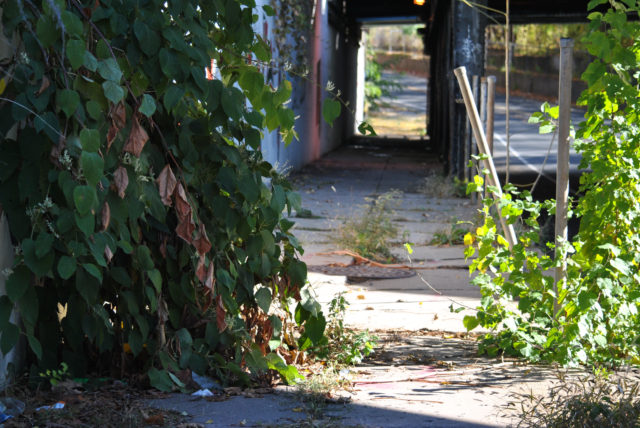
Day Eleven: Elizabeth Park, at least, has kept its loop road open for people still. It really makes a difference, being able to enjoy flowers without noise and exhaust only a few feet away. I notice that the newly renovated entrance on Fern Street has a crosswalk. There is no mid-block crosswalk on Prospect Avenue where people would naturally connect from the east to west side of the park following a path.
That’s not by a long shot the most challenging hurdle of my day, but it feels like low-hanging fruit to make areas around parks and schools more pedestrian-safe. I’m not even going to use that phrase “pedestrian-friendly” anymore. I don’t want friendliness. I want safety. Don’t smile at me. Keep me from getting run over.
There are so many opportunities for improvement. The intersection of Zion and Ward by the cemetery is one. It looks large enough to be converted to a roundabout. Crossing on foot is wild. There is no pedestrian signal. This is why you see people freewalking across other parts of the road. It makes more sense to do an unsanctioned mid-block cross on Ward where you are only dealing with traffic in two directions. When you have extensive experience as a person who moves about on foot, then you really grasp why people break the “rules” that were actually only designed to keep pedestrians from impeding motorists. I’ve looked at diagram-after-diagram of crashes that caused injuries to pedestrians, and at least half of them included people being exactly where they were legally allowed to be. If we aren’t guaranteed (or given something close to a guarantee) our safety by following the rules, then what incentive is there?
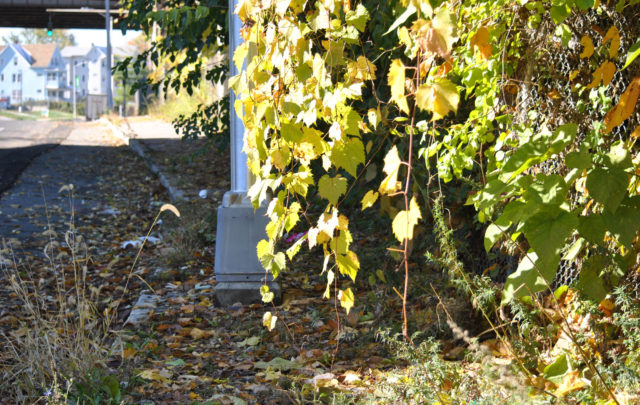
Day Twelve: Neighbors have begun requesting speed humps on my street and another that runs parallel. What this means is that there are people other than me telling the City that it needs to do better, that it needs to make the place we call home safer for those walking and biking. Often, I hear the suburban folks get nostalgic about how they used to play in the streets, and it’s a sure bet that this statement gets followed by their thoughts on how kids today don’t do this. Except they’re wrong, and they don’t even know they’re wrong because they aren’t going into the neighborhoods where this still happens. The children in my neighborhood continue to play on the quieter streets. There is a basketball hoop. They ride their bikes around. There are drivers who get irritated with them, as if only adults using cars have a right to the street. Streets are public space and belong to everyone.
My neighbors want the speedhumps to be steep and unmarked. There are people who fly through here, often the wrong way. Potholes, left unfilled, would serve the same purpose. We will hear the whining about drivers (who omit how fast they were traveling) who pop or fear popping a tire. What they need is an attitude adjustment. Being forced to slow down means they have been potentially saved from themselves, and saved from harming another person. Since the speed humps went in on a nearby street, there has been a noticeable decrease in roadkill.
By the school, drivers are still swinging into the crosswalk to make u-turns. There are now no cones in front of it, and nothing except common sense to tell drivers to stay out. One starts to drive onto the sidewalk by the school to let their children out. I wave my arms at them because this happens just few away from me. There are school security staff also nearby, but they are doing nothing about it.
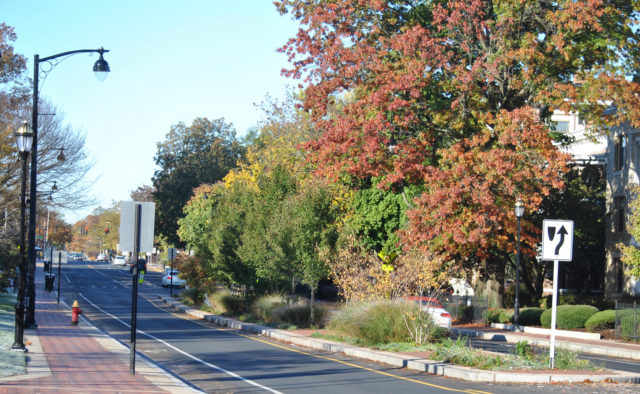
Day Thirteen: It’s the second of several rainy days. People are still driving as if hydroplaning is not a thing they need to worry about. I dodge getting splashed. The light at Woodland and Niles turns red, and I watch as one, two, three cars plow through after the pedestrian signal gives me the go ahead. A few weeks ago I noticed car debris just feet away from a bench outside the church at this intersection. It’s chilling to think someone could have been sitting there and hit by a wayward car or its pieces.
So, I wait. I am as careful as I can be while also being reasonable about getting to my destinations. If a crosswalk signal will not activate because it is broken or frozen, I will eventually cross instead of walking a half mile out of my way until I get to a working signal. I know that if I get hit, I will be assumed guilty until proven otherwise. There is an attitude held toward those who commute by foot or bike, and much of that is tied into attitudes about wealth. I have time to contemplate all this while waiting and waiting and waiting to get the pedestrian signal.
I wait until it’s clear. I stay on the painted crosswalk. I have on a reflective scarf, gloves, shoelaces, and armband. I’m carrying a bright yellow umbrella. The sun has not set so invisibility should not be used as anyone’s excuse anyway, but I spend so much time anticipating drivers’ idiocy, carelessness, and heartlessness. While waiting for lights, I can easily see into most vehicles. I know how many people are looking at their phones instead of the road. Today, I make it home in one piece.
That night, a friend’s Instagram post makes me stop cold. I recognize the landscape, yet there’s something disorienting about the image. It’s the angle. He’s lying in Farmington Avenue. There’s an SUV pulled into the bicycle lane. It’s license plate is legible in the pic, and presumably why he bothered to take an injury selfie.
It could have been worse, and I know this because I am learning about it via Instagram and not through a formulaic newspaper article. His injuries are survivable mainly because the driver was traveling below 30 MPH.
Is he okay?
He suffered a fractured knee, dislocated shoulder, and a broken toe. He’ll recover, but he’s not a spring chicken. I called him at the hospital, where he has spent the past few nights. He already had one operation. He’s basically immobile. At some point, he will be trained to use a special walker. To address the shoulder, he might need surgery.
He lives in an apartment building, on one of the upper floors. The elevator has been broken for some time, and to even access that, there are a few steps he will have to use. He’s hoping that by the time he is discharged from the hospital, the building’s accessibility issues will be fixed.
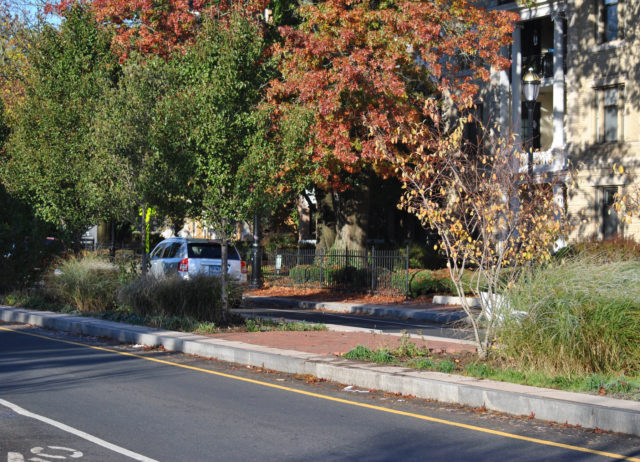
The situation perplexes me, in spite of all my exposure to crash data. I don’t understand how someone could drive into him. I’ve walked around with him in the past and can attest to the fact that he is cautious.
This happened during daylight, on a very straight stretch of Farmington Avenue where there are no obstructions.
At 6’4” and not a twig, my friend is exceptionally visible. Where was the driver looking that they did not notice a large man crossing the street? To this driver’s credit, they stopped, apologized, had an appropriate emotional response, and called 911. While he was still in the road, another driver got impatient with the backed up traffic and started passing cars by way of the bike lane. Go ahead for a minute and imagine what that’s like, to have just been rendered immobile and then see another vehicle coming at you. Lucky for him, there were people present who prevented that selfish person from running him over.
This happened on Farmington Avenue where raised medians were installed to create places of pedestrian refuge. This, combined with the sheer number of apartment buildings on this stretch of the road, should be enough to signal to drivers to look for pedestrians.
He had just gotten off the bus and was crossing at the median, where the surface absolutely suggests it is a place for people to stand while getting from one side of Farmington Avenue to another. You can see these medians in the two photos above and one below.
My friend, who is not cavalier about crossing streets, was issued a $90 ticket.
To say I experienced a rollercoaster of emotions is to put it mildly. Sadness: someone drove their vehicle into my friend, causing him multiple injuries. I’m not a fan of my friends experiencing pain. Gratitude: he survived. Outrage: how are drivers so careless?! How do cops write a ticket when someone is in the implied crosswalk?! How do they write a ticket when the victim is still lying in the street? Exhaustion: How many more friends and acquaintances will drivers hit with their cars this year? Dread: I have fourteen fewer inches of height than he does; if a driver can run him down, I don’t stand a chance.
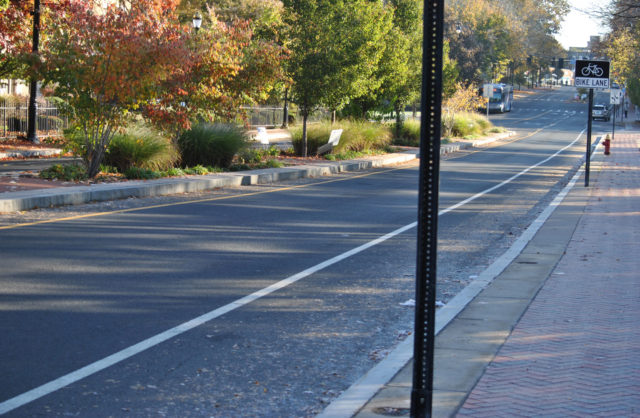
Pedestrian Deaths Across Connecticut in October 2020
Raquel Vasquez, just hours after killing Madeline Feliciano and critically injuring Oscar Ramos-Garcia at the intersection of Park and Washington in Hartford, was arrested and charged with operating under the influence, evading responsibility resulting in injury, evading responsibility resulting in death, manslaughter in the second degree with a motor vehicle, assault in the second degree, reckless endangerment, reckless driving and operating an unregistered motor vehicle. They could have applied the Vulnerable User Law, but didn’t, and we’re unlikely to see that put to use until bicycle and pedestrian advocate organizations get loud about it.
The quick arrest following the fatal hit-and-run is unusual, though, and a welcome change. If any arrest has been made in the killing-by-car of Luis Daniel Rodriguez — struck down while riding in one of Hartford’s bicycle lanes — that has not been publicized. Many of those who killed pedestrians and cyclists in Connecticut this year have gotten away with it, either because they have not gotten caught or because the system doesn’t think our lives are worth more than a slap on the wrist.
I wish I could say more about Feliciano. She lived in the neighborhood, just blocks from where she was hit, and was using a wheelchair to get wherever she had been going. There is no obituary that I can find.
Less than one week after Vasquez hit two people in Hartford, a 25-year old Yale law student was killed in New Haven. Keon Ho “Chris” Lim was cycling through the poorly designed intersection of York and South Frontage, and following the advice that cyclists are repeatedly given — stay as far to the right on the roadway as possible, so as not to be an inconvenience to cars. New Haven’s mayor, in comments to the media, implied that Lim had attempted to merge into the center lane but due to heavy traffic was unable to make that move.
Put in a damned if you do, damned if you don’t situation, Lim was fatally injured when the driver of a box truck turned right from a center lane (where that turn was permitted). into the victim, who had been continuing straight despite being in the right turn lane. The news reports and crash diagram contradict one another when it comes to whether the truck hit Lim or if the cyclist rode into the side of the truck, and if so, which part of the truck.
This intersection is a known problem for vulnerable road users. Two pedestrians were killed here in 2008 and 2017. This year-to-date, there have been twelve preventable deaths of pedestrians and cyclists in New Haven alone.
Also in October, a 67-year old male — whose identity has not been made public, if it is known at all — was killed in Waterbury. This was another case of a driver refusing to take responsibility for his or her actions. The man was pushing a shopping cart when hit around 8:15 PM near 760 Wolcott Street. NBC30 stated that the assailant “kept driving with the pedestrian still on the hood of the car, according to police. Police said that when the car took a right turn, the pedestrian rolled off the hood of the car and fell onto the street.”
To put it another way, there is no possibility that the driver was unaware that he or she collided with a person.
The victim suffered leg and head injuries, and died 48 hours later in the hospital.
The driver drove away.
Since January 1, 2020, at least 50 pedestrians and cyclists have been killed in Connecticut following strikes by or collisions with motor vehicles.
Since February I have shared with you statistics, obituaries, laws, history, current trends, explanation of Complete Street infrastructure, maps, and photos. What I have not shared is my daily experience as a person who walks to work — and for the last few months and foreseeable future — and to anywhere else I want or need to go. Throughout October, I kept notes. Here is what I experienced on thirteen days.
Day One:
I get off at the wrong bus stop in West Hartford because I am on a route I’ve never used before. This means a 1.5 mile walk when I expected to go about .25. Fine. Except that in this distance, there is only one painted crosswalk. Most of this walk is along a high-speed stroad. Laughably, they painted sharrows on it. I see many cyclists, but they are all on the sidewalk, not on the street — because those teens are not idiots! Well, all teens except for one adult who probably just got off his shift in a retail area where buses show up every half hour or hour, not every ten minutes. He is also on the sidewalk. Every intersection I cross — only one of which has a pedestrian signal — I hold my breath and pray while walking. Again, only one of these eleven intersections has a painted crosswalk, which means that if I get hit by one of the bloated vanity trucks that dominates the roadways, the news will report that I was not in a crosswalk because most journalists do not understand that unmarked crosswalks remain legal crosswalks. Hell, most cops don’t get that either.
Why didn’t I just take the more convenient bus that I had ridden before? Coronavirus. This was my first time on a bus since March, and I knew one route had fewer riders in general, which would seem like a safer bet for my health. These are the decisions you get to make when you are car-free: do I put myself on a bus where I may not have ability to be more than six feet away from another person but am dropped off at my destination, do I take a less convenient (i.e. more distant) bus reducing my exposure to COVID but still exposing myself to many opportunities to get run over by careless drivers, or do I walk three miles and stay off public transportation feeling confident about the air I’m breathing but having many, many conflicts with drivers while exhausted after working all day and those three miles only account for getting to the store; getting home means asking all these questions again, but with an extra two miles of walking potentially tacked on.
My return trip meant taking another less popular bus route, but this was a route I had taken before and I knew where all the stops were. The inconvenience cost me only seven more minutes instead of 25, and in this case, far fewer street crossings, all of which had painted crosswalks. Paint does not protect me physically, but perhaps when I am splattered across the pavement, the painted crosswalk will protect my reputation as a rule follower who could not be protected by the rules.
Day Two: The morning begins with entering another 311 complaint for an issue that had not been dealt with: cars being parked in a crosswalk by an elementary school. There are ample security guards around the school (including two who chat every morning by the corner where the cars are parked, one of whom does not wear a mask) and a crossing guard at this intersection. While they may not have the legal authority to enforce anything, it is beyond me why people — whose entire job involves safety — would not ask someone to move their vehicle to a place conducive to maintaining the safety of children. Listen, I get that drivers do not always listen. I’ve volunteered at a farmers’ market where part of my role involved telling people they could not park in the bike lane or in a travel driveway, and that they should move to the spacious parking lot that had about twenty signs pointing to it. People can be rude and act entitled, use coarse language, and simply ignore the instruction, but, many will move their vehicles along. Why wouldn’t they just try?
It’s an irritating way to begin the day, with this reminder that people believe cars are allowed everywhere, including spaces that are designated for people. We are battling another plague in America, and it’s called the absence of empathy.
By the time I am nearly to work I am in a mood. Walking should be relaxing. But all around, I see a world that has been reconfigured to meet trashy ideals and utter laziness.
And then I see the thing that makes me want a cocktail before 9 AM: landscapers using leafblowers to move pine needles off a driveway and into the roadway, right where cyclists are most likely to be riding. Nevermind that I do not understand how leaf blowers have replaced rakes, nevermind that their use is almost always to make something look neater than to actually address an issue, and nevermind that was I observed is super common and not necessary: there is a large green space that those needles could have been moved to; the street was not the only option. Nevermind the ridiculousness of moving leaves and other vegetation off private property and into public space. What I witnessed here and many other times is an absence of caring about how one person’s actions impact others.
Let’s think about those needles. Pine needles, in case you’ve never experienced them yourself, are slippery. What does it mean when one person takes a slipping hazard and moves it to a public space? Think about what it means to pile leaves into the bike lane or across a sidewalk. The message is that how the property owner looks (by way of how his/her lawn looks) is far more important than the safety of someone walking or cycling to work. I could explain it step-by-step what it means to constantly swerve around leaf piles, becoming that “unpredictable” cyclist that we are told not to be, or what it means to have to step out into the roadway because a sidewalk is blocked, and if that pedestrian gets hit by a car, you can guess what the news will report: it won’t be the obstacle that person was avoiding; only that the person was walking in the roadway, as if people do this without reason.
You might think of these things as small matters, but they aren’t. These obstacles can force someone into a split second decision that results in death. All because someone couldn’t be bothered to bag leaves or just leave them on the lawn where they fall.
Day Three: To vote by absentee ballot, I take a detour on my way to work, swinging through Parkville so that I can place my envelope into the drop box. This is in front of a school and senior center. It takes all of three seconds, plus the time to douse my hands with sanitizer. Then, I wait for the pedestrian cycle. The intersection of Park Street, New Park Avenue, and Sisson Avenue is a cross-stroad. It’s bloated and teeming with entitlement. Nobody uses the stop lines. Those are the solid white lines by the intersection that the vehicle is supposed to stay behind when unable to clear it.
Here, the crossing guard has the guts. She blows her whistle at the driver who decided to block the crosswalk with his pickup truck after all lights turn red and people on foot finally have the right-of-way.
In the West End, the crossing guard pops out into the street with his sign. This is notable because there are no kids in the intersection, and over the years, he has consistently made the kind gesture of serving as reinforcement when adults are crossing. Here, everybody gets an extra layer of protection, regardless of age.
This morning I find myself missing the crossing guard who used to patrol Russ Street at Putnam Street until she retired a year or so ago. She was the right kind of terrifying and would absolutely stop traffic. By the way she greeted the students, you could tell that she felt her job on a personal level, that she was there to actually protect and serve.
Day Four: I am pleasantly surprised to see that someone figured out a simple way to solve the problem of selfish drivers parking in the crosswalk by an elementary school: cones. That’s all I ever wanted. Not cops to come by and potentially exacerbate a situation. Just physical barriers (well, obstacles, really) set down where they should have been in the first place. It’s not perfect, but I did not have to be the person to relocate traffic cones from where they are serving no function to where they can give pedestrians a little more of a fighting chance.
But before I see this, I pass a loud altercation. Another entitled driver up the road is yelling at a bus driver. He parked his car several feet away from the curb, making it so that the school bus had to be overly maneuvered to get through the space remaining. Who yells at school bus drivers?! The same people who think that they are allowed to park any which way because they did not leave the house early enough to get their kid to school on time.
Day Five: There are fire trucks parked all over Park Street near Orange Street. Common sense says people should slow down and use extra caution. Instead, cars are still zooming on this stretch of road, and I nervously watch as a pedestrian uses an unmarked crosswalk, knowing that if she gets hit, the news crew will describe her as jaywalking.
This is on the section of Park Street that I and others have reported to 311 as needing traffic calming. There are no significant bumpouts or anything at all that slows traffic. I continue to implore the business and property owners in this area to step up to do something, but it’s spitting into the wind. A shiny new development has no front door access. Color me shocked that the centerline yield signs are never where they should be. If you think I’m grumpy, wait til one of the hipsters gets hit by a car. Just wait. It’s when, not if.
Day Six: We have been in a drought, but today is pouring rain. I have a change of clothes in my bag so that I don’t need to shiver all day at work. That’s experience talking. Every time it rains, there are three ways for me to get soaked: (1) If the rain is coming at an angle, making my umbrella less protective, (2) getting splashed by the morons who are driving too fast for conditions, and (3) while crossing roads where nobody has bothered to clean the storm drains.
Today, I manage to be spared by drivers, and do not have to wash disgusting puddle water off my face. My feet, however, are drenched. The storm drain at Putnam and Russ has been clogged for months. When the construction crew set out barrels, one was placed blocking a curb cut ramp. Besides impeding wheelchair access, it has become a thing for leaves and litter to congregate against. In the suburbs, you would see maintenance right next to a school. In one of the poorest neighborhoods in Connecticut, there is no such luxury. I mean, a squirrel has been rotting away in the school drop-off zone for weeks. Sure, some crew played with their leaf blowers on the lawn one day when it was there, but you can’t expect someone to stop playing with their loud toys and actually remove a hazard. It’s frustrating to have to constantly report such things to 311 for there to be any hope of getting things done.
The storm drain was completely blocked. Dirt from the construction project washed down, gathering over all the garbage and leaves. There was no way to get around the puddle without going in a different direction. So, my feet were soaked in less than five minutes outside, and there would still be other intersections with puddles. It does not help matters that the storm drains and curb ramps often overlap or are too close to each other to be of benefit to the pedestrian. Even if the one by the Burns School had the cone removed so you could walk off that instead of having to step off a curb, the drain remains an issue. Maybe I see it this way because there is no maintenance of it here, and that is typically the case elsewhere.
I get to work. Head straight to the bathroom, after remembering that I had more spare clothes in my locker. I opt for wool socks from there. I shove paper towels inside my boots to soak up water while I’m changing my socks and pants. Everything is great until slowly, my socks begin to get saturated with water remaining in the boots. I spend the day with damp feet. You can imagine what that does to a mood, but at what point do you say enough? How many pairs of spare socks should I keep at work because the City of Hartford will not maintain its property? How many spare pants should I keep there because drivers will, rather than pause while the car in front of them makes a left turn, weave to pass on the right, dislodging a puddle with their impatience and selfishness?
I’m asked why I don’t take the bus when it rains. Simple. The bus makes no difference. I still have to walk .4 mile to get to the bus stop — and that means going through the same intersection. With the major construction project on Park Terrace, there is no shorter alternate route. Then, on the other end, I still have another .4 mile walk from the closest bus stop on that route. I pay money to stand around and wait for a bus that only shaves about .7 mile of walking, most of which is not the part with massive puddles? No. Why don’t I take Uber or Lyft? COVID-19 concerns aside, it feels like a waste of money and like taking an unnecessary risk to get in a car with what is almost always someone who drives too fast for conditions.
You know what is inevitable though, when you have walked about two miles in the pouring rain? Hearing someone talk about where they parked so they could avoid getting wet for thirty seconds.
Day Seven: One step forward, two steps back. A car was parked again in the crosswalk. How many cones are needed to tell someone that this space is not for them? How much pavement do drivers feel entitled to? Why is there so much entitlement? There is no shortage of parking in the neighborhood. There is no reason for someone to park in a crosswalk. To get anything done, I would have to contact the police because no other department seems to think it’s their responsibility to follow up with the construction crew and ask that signs and cones be moved to be sensible and functional. You would think that a clear ADA violation would have done it, but no.
Besides not wanting to call the police because this should not be a police matter, there’s another thing: it’s not like I’m taking walks for funsies when I observe this garbage. I’m usually walking with purpose — going to or from work. While I think I am responsible by leaving early so that there is some flexibility and I’m not late, I definitely bite into that time whenever I stop to record something with 311. In this case, there’s nothing for me to be late to except starting dinner, but I’m tired and a phone call with a dispatcher will be unpleasant because I do not like repeating myself three times. Again, I fantasize about moving the cones to where everything should have been placed the first time. I fantasize about smashing the windshields of being too dumb to operate a potentially lethal piece of machinery. But I don’t do those things. Instead, I go home, make dinner, and try to tell myself it’s okay that I not attempt to make shitty things better, even if it seems like few others care to do their share of heavy lifting. I let myself do what I never do: nothing.
Day Eight: Before I leave the house I am sending an email to Complete Streets asking if they can get a more appropriate department to address the pedestrian accessibility issues at Putnam and Russ — from the cars in the crosswalk to the blocked curb cut ramp.
For the first time I’m regretting not spending my adult life working out; if I had the physical strength, I would just move things myself. It would be weeks before the City of Hartford noticed something changed.
How do I know?
The photos in this post of the Capitol Avenue sidewalks partially and completely obstructed by vegetation — I reported those issues using Hartford’s 311 app. I first reported it back in July. And again in August. Then, later in August. And in September before school began. And once more at the beginning of October. These photos were taken October 31, 2020.
Day Nine: I am told to go check out the intersection of Russ and Putnam to see if the construction crew fixed the situation. The sign blocking the curb ramp has finally been moved, restoring access for those using wheelchairs and strollers. . . after months.
I should be grateful, but I have to ask why it was not done mindfully the first time. Because the sign is moved, it seems the storm sewer won’t get backed up as easily either. But, I notice that all but one cone has been moved away from the crosswalk, making it more possible for people to continue driving into it.
This is frustrating.
We don’t need cops. We need physical barriers.
Physical barriers are what keep almost all motor vehicles out of bike lanes and walking paths. They are what prevent people putting their cars into places they should not.
We also need people to raise their children up right, to be less self-centered. People who commute by foot or wheelchair or bicycle should not have to beg to be safe.
Day Ten: It’s the weekend, so I have time to visit Goodwin Park. I decide to stop by the post office on the way, which means walking through the intersection of Park and Washington Street in Hartford. That’s where Madeline Feliciano was killed about two weeks prior. While waiting my turn to cross, I glance at the people waiting at other corners. Are they feeling a little nervous too, knowing what happened here? Do they wonder if drivers will stop when the light tells them to?
On the way to the city’s South End I notice cars parked in the relatively new bike lane on Maple Avenue. People park cars in bike lanes when there is (1) no physical barrier keeping them out, or (2) no consistent ticketing and towing of vehicles parked in bike lanes. I abhor sharrows, but in a way, they are more honest than a bike lane that is nothing more than paint.
At Goodwin Park I notice that they have taken park space away from people again, allowing cars to drive through. There are two just idling near a wooded area that should be a space of quiet. It’s not cold enough for heat. By the pond, there are more just sitting there, idling.
In Old Wethersfield — yes, I walked there — I see a scarecrow display assembled by Bike Walk Wethersfield. It’s at the corner of an overly wide intersection and it features skeleton people on bikes, including a small child. It’s a little bit cute and a little bit jarring, and I suspect, it may be the only reason drivers were consistently stopping and waiting for pedestrians. I want displays like this installed at every intersection.
Day Eleven: Elizabeth Park, at least, has kept its loop road open for people still. It really makes a difference, being able to enjoy flowers without noise and exhaust only a few feet away. I notice that the newly renovated entrance on Fern Street has a crosswalk. There is no mid-block crosswalk on Prospect Avenue where people would naturally connect from the east to west side of the park following a path.
That’s not by a long shot the most challenging hurdle of my day, but it feels like low-hanging fruit to make areas around parks and schools more pedestrian-safe. I’m not even going to use that phrase “pedestrian-friendly” anymore. I don’t want friendliness. I want safety. Don’t smile at me. Keep me from getting run over.
There are so many opportunities for improvement. The intersection of Zion and Ward by the cemetery is one. It looks large enough to be converted to a roundabout. Crossing on foot is wild. There is no pedestrian signal. This is why you see people freewalking across other parts of the road. It makes more sense to do an unsanctioned mid-block cross on Ward where you are only dealing with traffic in two directions. When you have extensive experience as a person who moves about on foot, then you really grasp why people break the “rules” that were actually only designed to keep pedestrians from impeding motorists. I’ve looked at diagram-after-diagram of crashes that caused injuries to pedestrians, and at least half of them included people being exactly where they were legally allowed to be. If we aren’t guaranteed (or given something close to a guarantee) our safety by following the rules, then what incentive is there?
Day Twelve: Neighbors have begun requesting speed humps on my street and another that runs parallel. What this means is that there are people other than me telling the City that it needs to do better, that it needs to make the place we call home safer for those walking and biking. Often, I hear the suburban folks get nostalgic about how they used to play in the streets, and it’s a sure bet that this statement gets followed by their thoughts on how kids today don’t do this. Except they’re wrong, and they don’t even know they’re wrong because they aren’t going into the neighborhoods where this still happens. The children in my neighborhood continue to play on the quieter streets. There is a basketball hoop. They ride their bikes around. There are drivers who get irritated with them, as if only adults using cars have a right to the street. Streets are public space and belong to everyone.
My neighbors want the speedhumps to be steep and unmarked. There are people who fly through here, often the wrong way. Potholes, left unfilled, would serve the same purpose. We will hear the whining about drivers (who omit how fast they were traveling) who pop or fear popping a tire. What they need is an attitude adjustment. Being forced to slow down means they have been potentially saved from themselves, and saved from harming another person. Since the speed humps went in on a nearby street, there has been a noticeable decrease in roadkill.
By the school, drivers are still swinging into the crosswalk to make u-turns. There are now no cones in front of it, and nothing except common sense to tell drivers to stay out. One starts to drive onto the sidewalk by the school to let their children out. I wave my arms at them because this happens just few away from me. There are school security staff also nearby, but they are doing nothing about it.
Day Thirteen: It’s the second of several rainy days. People are still driving as if hydroplaning is not a thing they need to worry about. I dodge getting splashed. The light at Woodland and Niles turns red, and I watch as one, two, three cars plow through after the pedestrian signal gives me the go ahead. A few weeks ago I noticed car debris just feet away from a bench outside the church at this intersection. It’s chilling to think someone could have been sitting there and hit by a wayward car or its pieces.
So, I wait. I am as careful as I can be while also being reasonable about getting to my destinations. If a crosswalk signal will not activate because it is broken or frozen, I will eventually cross instead of walking a half mile out of my way until I get to a working signal. I know that if I get hit, I will be assumed guilty until proven otherwise. There is an attitude held toward those who commute by foot or bike, and much of that is tied into attitudes about wealth. I have time to contemplate all this while waiting and waiting and waiting to get the pedestrian signal.
I wait until it’s clear. I stay on the painted crosswalk. I have on a reflective scarf, gloves, shoelaces, and armband. I’m carrying a bright yellow umbrella. The sun has not set so invisibility should not be used as anyone’s excuse anyway, but I spend so much time anticipating drivers’ idiocy, carelessness, and heartlessness. While waiting for lights, I can easily see into most vehicles. I know how many people are looking at their phones instead of the road. Today, I make it home in one piece.
That night, a friend’s Instagram post makes me stop cold. I recognize the landscape, yet there’s something disorienting about the image. It’s the angle. He’s lying in Farmington Avenue. There’s an SUV pulled into the bicycle lane. It’s license plate is legible in the pic, and presumably why he bothered to take an injury selfie.
It could have been worse, and I know this because I am learning about it via Instagram and not through a formulaic newspaper article. His injuries are survivable mainly because the driver was traveling below 30 MPH.
Is he okay?
He suffered a fractured knee, dislocated shoulder, and a broken toe. He’ll recover, but he’s not a spring chicken. I called him at the hospital, where he has spent the past few nights. He already had one operation. He’s basically immobile. At some point, he will be trained to use a special walker. To address the shoulder, he might need surgery.
He lives in an apartment building, on one of the upper floors. The elevator has been broken for some time, and to even access that, there are a few steps he will have to use. He’s hoping that by the time he is discharged from the hospital, the building’s accessibility issues will be fixed.
The situation perplexes me, in spite of all my exposure to crash data. I don’t understand how someone could drive into him. I’ve walked around with him in the past and can attest to the fact that he is cautious.
This happened during daylight, on a very straight stretch of Farmington Avenue where there are no obstructions.
At 6’4” and not a twig, my friend is exceptionally visible. Where was the driver looking that they did not notice a large man crossing the street? To this driver’s credit, they stopped, apologized, had an appropriate emotional response, and called 911. While he was still in the road, another driver got impatient with the backed up traffic and started passing cars by way of the bike lane. Go ahead for a minute and imagine what that’s like, to have just been rendered immobile and then see another vehicle coming at you. Lucky for him, there were people present who prevented that selfish person from running him over.
This happened on Farmington Avenue where raised medians were installed to create places of pedestrian refuge. This, combined with the sheer number of apartment buildings on this stretch of the road, should be enough to signal to drivers to look for pedestrians.
He had just gotten off the bus and was crossing at the median, where the surface absolutely suggests it is a place for people to stand while getting from one side of Farmington Avenue to another. You can see these medians in the two photos above and one below.
My friend, who is not cavalier about crossing streets, was issued a $90 ticket.
To say I experienced a rollercoaster of emotions is to put it mildly. Sadness: someone drove their vehicle into my friend, causing him multiple injuries. I’m not a fan of my friends experiencing pain. Gratitude: he survived. Outrage: how are drivers so careless?! How do cops write a ticket when someone is in the implied crosswalk?! How do they write a ticket when the victim is still lying in the street? Exhaustion: How many more friends and acquaintances will drivers hit with their cars this year? Dread: I have fourteen fewer inches of height than he does; if a driver can run him down, I don’t stand a chance.
Related Posts
Suggestion Box: More Festive Winterfest
Dispatches from the Alleged Ghost Town (Volume 33)
Look: Exit, No Exit